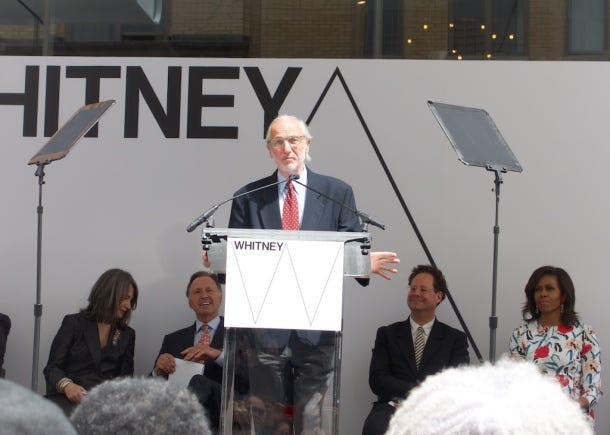Ribbon-Cutting at the Whitney
“We got to make a building that flies,” said Renzo Piano, the architect of the new Whitney Museum of American Art, in Manhattan’s Meatpacking District. “I know buildings don’t fly… But the destiny of an architect is to fight against gravity.”
Piano was standing behind a podium in front of the museum, which from some angles seems indeed to defy the laws of physics. With its sloping gray surfaces, and the way it hovers in the air suspended on thin columns, the building resembles a spaceship version of Michael J. Fox’s DeLorean in Back to the Future.
It was the last day of April, perfectly cool and sunny, and Piano was there to help dedicate the building. “I love making buildings,” he said, in his raspy Italian accent. “But I especially love making buildings for public use.” For him there was no higher purpose than designing buildings dedicated to art:
The reason is very simple. Because art and beauty make people better people. Beauty switches on in the eyes of people a special light. Beauty builds curiosity, it builds desire. In the same way [that] art makes people better people, building for art makes the city a better place to stay and to live.

Renzo Piano at the Whitney's ribbon-cutting ceremony, on April 30th
-
He concluded by telling the crowd of 300 that was seated on Gansevoort Street that beauty would save the world. And then, to ecstatic applause: “The building is yours!”
When the previous Whitney was dedicated, in 1966, Jacqueline Kennedy cut the ribbon, and rumor had had it that the tradition would continue. Sure enough, at 4:30 AM that day, the Secret Service had begun a sweep of the new building, even removing ceiling tiles to examine spaces between the floors. Snipers lurked on the roof. A garbage truck was parked sideways at the western end of the block, for added protection. Bald men wearing sunglasses and earpieces stood in ponderous poses.
After Mayor de Blasio had delivered some eloquent words---there was something F.D.R.-like about him, his charisma competing with his height---followed by a few speakers that included the granddaughter of the Whitney’s founder, First Lady Michelle Obama stood and approached the podium. She made her love for the new building clear. “This is the most beautiful freight elevator I’ve ever ridden on!” she said, referring to the artist-designed elevators that are their own little universes. “Just about every space in this museum is magnificent.” Her remarks tied the new Whitney’s first exhibit, “America Is Hard To See,” to the challenge of inclusiveness in a nation of immigrants, where vast swaths of citizens remain out of sight:
With this inaugural exhibition, the Whitney is really sending the same message to young people and to people of every background across the country. You’re telling them that their story is part of the American story. And that they deserve to be seen.
Michelle was more posed than de Blasio---she read from a teleprompter---but she shared some of her husband’s oratorical skill, including the tendency to inject an occasional quip. The message was clear: this institution was about celebrating the American experience, which meant celebrating the voices of people from all walks of life, of all identities. She praised the museum’s educational programs, bringing young people into the museum to expose them to something that might plant a seed that would pay dividends---emotional, artistic, economic---in future decades. She urged leaders to use technology to reach children who’d otherwise never experience serious art: “One visit, one performance, one touch, and who knows how you could spark a child’s imagination?”

When she finished speaking, the Wooster Group, an experimental theatre company, performed a perplexingly ironic ribbon-cutting ceremony. The crowd then went into the lobby for a glass of champagne.
The atmosphere that attended the Whitney’s opening celebrations, wrote Roberta Smith in The New York Times later that day, was “euphoric, unlike anything I’d experienced in over four decades in the New York art world. Now we know how it feels... when a museum emerges bigger but better from the excruciating process of building a new home.”
At the ribbon-cutting ceremony, she said, “the city’s cultural metabolism seemed to quicken noticeably as successive speakers affirmed art’s importance to society.”
Having raised 760 million dollars---which provided for construction as well as the endowment---the Whitney is poised to take off, both as an institution and as a cultural lodestar in the Meatpacking District, the little triangle between the West Village and Chelsea whose streets only recently were lined with hanging carcasses. The piazza on the ground floor, over which the museum hovers like a mothership, is unlike anything in Manhattan, luring traffic from the southern end of the High Line and into the first-floor gallery, which is free to the public, and into a beautifully sparse restaurant, cased in exquisite German glass. The scene is like something out of a futuristic vision of Paris.
After eight years, the moment has arrived. Renzo Piano---together with the hundreds of people who’ve given their time, imagination, and money to the Whitney’s radical vision---is doing what he can to save the world.